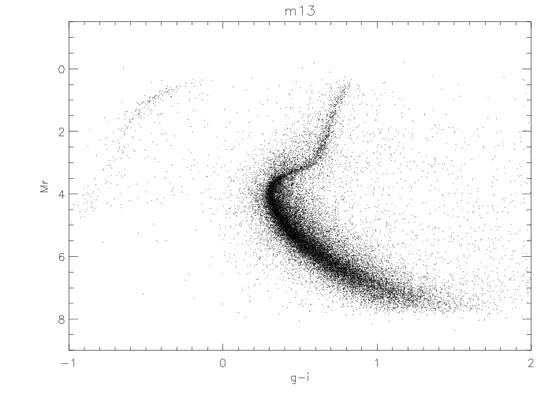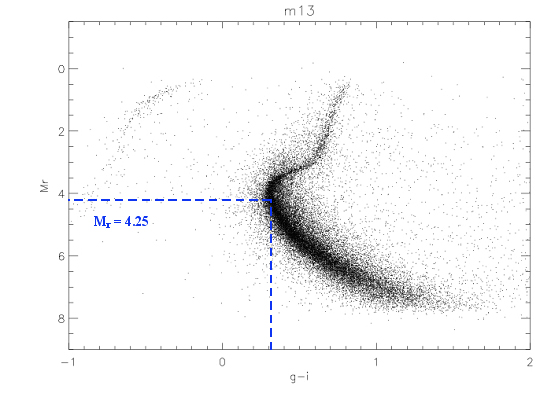Finding the distance
Main Sequence Fitting
Main sequence fitting involves the fitting of one clusterís main sequence to another clusterís main sequence. At first glance this may seem irrelevant, but it is the key to finding the distance to M3. We make another H-R diagram, but this time we will do it for a cluster with a known absolute magnitude. Shown below is a plot of M13.

Figure 4: H-R diagram of M13, obtained by plotting Mr vs g-i.
In this case, we are plotting absolute instead of apparent magnitude on the y-axis. The x-axis is still g-i. What we now need to do is find the absolute magnitude of M13ís main sequence at the g-i value of M3ís turn off point, which we found to be 0.3. Matching up the g-i value to M13 gives an absolute magnitude of about 4.25. This gives us the absolute magnitude of M3's turn off, although it might not seem obvious at first glance. The g-i value of a star on the main sequence is unique to a specific spectral type, and we know the absolute magnitude of a star on the main sequence is fairly constant. Therefore, if we measure the absolute magnitude of M13's main sequence at the g-i value of M3's turn off, we are actually measuring the absolute magnitude of M3's turn off point.

Figure 5: H-R diagram of M13. The absolute magnitude of the main sequence at g-i = 0.3 is about 4.25.
Now that we have the absolute and apparent magnitudes of M3ís turn off point, we can use the distance modulus to calculate the clusterís distance. Plugging in the appropriate values for m and M gives
4 = log(d)
d = 10000
So the distance to M3 is approximately 10,000 parsecs, or 32,616 light years. Using the distance modulus from Rood et. al 1999, we get a distance of 34,628, so we are off by 2012 light years. Not too bad for an estimate!
To summarize, there are four main points:
- Find the g-i and r values of the main sequence turn off
- Find a cluster with a known absolute magnitude
- Find the absolute magnitude of the main sequence at the determined g-i value
-
Calculate the distance to the cluster using the distance modulus